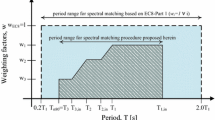Abstract
It is important to select proper ground motions for accurately estimating seismic demands using linear and nonlinear response history analyses (RHA). Current seismic design provisions such as ASCE 7–10 provide criteria for selecting ground motions. In this study, an accurate and computationally efficient algorithm for selecting and scaling ground motions is proposed, which satisfies the ASCE 7–10 criteria. The ASCE 7–10 ground motion selection criteria with the proposed algorithm is assessed using the results of nonlinear response history analyses of twelve single degree of freedom (SDF) systems and one multi-degree of freedom (MDF) system. In order to investigate the effect of the numbers of selected ground motions, period ranges for spectral matching, library sizes, and structural periods on selection results, parametric studies are conducted based on the results of nonlinear RHA. This study shows that the target seismic demands for all model SDF and MDF systems can be predicted using the mean seismic demands over seven and ten ground motions selected according to the proposed method within an error of 30 and 20%, respectively.
















Similar content being viewed by others
References
Araúj M, Macedo L, Marques M, Castro JM (2016) Code-based record selection methods for seismic performance assessment of buildings. Earthq Eng Struct D 45(1):129–148. doi:10.1002/eqe.2620
ASCE (2010) Minimum design loads for building and other structures (ASCE 7–10). American Society of Civil Engineers, Reston, Virginia. doi:10.1061/9780784412916
ASCE (2014) Seismic evaluation and retrofit of existing buildings (ASCE/SEI 41-13). American Society of Civil Engineers, Reston, Virginia. doi:10.1061/9780784412855
Ay BO, Akkar S (2012) A procedure on ground motion selection and scaling for nonlinear response of simple structural systems. Earthq Eng Struct D 41(12):1693–1707. doi:10.1002/eqe.1198
CEN (2004) ENV 1998-1 Eurocode 8: Design of structures for earthquake resistance—Part 1: general rules, seismic actions and rules for buildings. European Committee for Standardization, Brussels, Belgium
Chiou B, Darragh R, Gregor N, Silva W (2008) NGA project strong motion database. Earthq Spectra 24(1):3–44. doi:10.1193/1.2894831
FEMA (2009) NEHRP recommended seismic provisions for new buildings and other structures, FEMA P750. Applied Technology Council for the Federal Emergency Management Agency, Washington
Gupta A, Krawinkler H (1999) Seismic demands for performance evaluation of steel moment resisting frame structures (SAC Task 5.4.3). Report No. 132. John A. Blume Earthquake Engineering Center, Stanford University, Stanford
Ha SJ, Han SW (2016) An efficient method for selecting and scaling ground motions matching target response spectrum mean and variance. Earthq Eng Struct D 45(8):1381–1387. doi:10.1002/eqe.2702
Han SW, Seok SW (2014) Efficient procedure for selecting and scaling ground motions for response history analysis. J Struct Eng ASCE 140(1):06013004. doi:10.1061/(ASCE)ST.1943-541X.0000881
Han SW, Ha SJ, Seok SW (2014) Efficient and accurate procedure for selecting ground motions matching target response spectrum. Nonlinear Dyn 78:889–905. doi:10.1007/s11071-014-1484-0
Jayaram N, Lin T, Baker JW (2011) A computationally efficient ground-motion selection algorithm for matching a target response spectrum mean and variance. Earthq Spectra 27(3):797–815. doi:10.1193/1.3608002
Kalkan E, Çelebi M (2010) Assessment of ASCE-7 ground motion scaling method using computer model of instrumented high-rise building. Improving the seismic performance of existing buildings and other structures. San Francisco, pp 905–915. doi:10.1061/41084(364)82
Kottke AR, Rathje EM (2008) A semi-automated procedure for selecting and scaling recorded earthquake motions for dynamic analysis. Earthq Spectra 24(4):911–932. doi:10.1193/1.2985772
NZS (2004) NZS 1170.5: 2004 Structural design actions. Part 5: earthquake actions—New Zealand. New Zealand Standard, Wellington
PEER (2009) Open system for earthquake engineering simulation (OpenSEES). Pacific Earthquake Engineering Research Center, California University, Berkeley
Reyes JJ, Kalkan E (2012) How many records should be used in an ASCE/SEI-7 ground motion scaling procedure? Earthq Spectra 28(3):1223–1242. doi:10.1193/1.4000066
Shantz TJ (2006) Selection and scaling of earthquake records for nonlinear dynamic analysis of first mode dominate bridge structures. In: Proceedings of the 8th US national conference on earthquake engineering, San Francisco
Wang G (2011) A ground motion selection and modification method capturing response spectrum characteristics and variability of scenario earthquakes. Soil Dyn Earthq Eng 31(4):611–625. doi:10.1016/j.soildyn.2010.11.007
Acknowledgements
The authors thank Prof. Sinan Akkar for his constructive and helpful review comments. The valuable suggestions offered by anonymous reviewers are also greatly appreciated. We also would like to acknowledge the financial supports provided by the National Research Foundation of Korea (No. 2014R1A2A1A11049488).
Author information
Authors and Affiliations
Corresponding author
Rights and permissions
About this article
Cite this article
Han, S.W., Ha, S.J. Assessment of ground motion selection criteria specified in current seismic provisions with an accurate selection algorithm. Bull Earthquake Eng 15, 4113–4132 (2017). https://doi.org/10.1007/s10518-017-0149-z
Received:
Accepted:
Published:
Issue Date:
DOI: https://doi.org/10.1007/s10518-017-0149-z




